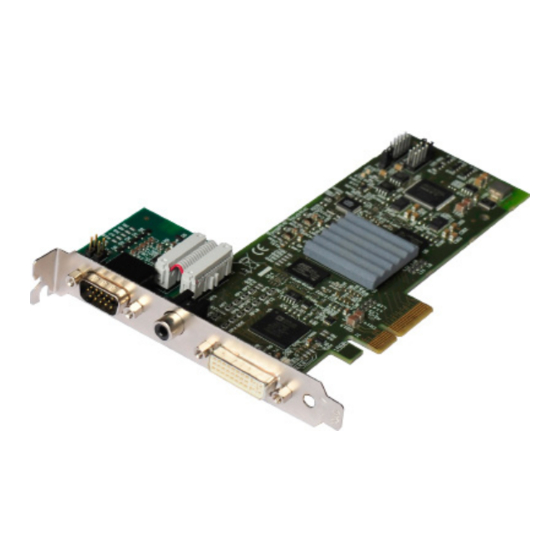
Table of Contents
Advertisement
Quick Links
Advertisement
Table of Contents

Summary of Contents for Datapath VisionAV/F
-
Page 1: User Manual
The VisionAV Audio/Video Capture Card User Manual Version 1.0.0... -
Page 2: Table Of Contents
Contents Introduction..................1 Dual Channel Video................2 Flexible Audio Capture.................2 Datapath Unified Vision Driver.............2 Models....................2 Specification..................3 Unpacking..................4 Installing the Capture Card..............5 DirectShow..................9 Software Installation................9 Application Overview................10 Using the card with other Datapath products........10 Datapath Limited................11 Index....................12... -
Page 3: Introduction
Introduction The VisionAV has two independent video capture channels – one supporting HD capture and a second simultaneously decoding Standard Definition composite video. The VisionAV also adds analog and HDMI audio capture, which can be perfectly synchronised with either video capture channel. • A single card solution for distance learning, lecture capture and web casting • Viewing analog or DVI sources from a wide range of PCs, MACs, Industrial/Medical equipment, cameras and other video equipment. -
Page 4: Dual Channel Video
Flexible Audio Capture • Balanced (XLR) and Unbalanced (RCA) from optional module • HDMI audio through HD Video Channel Datapath Unified Vision Driver • Multiple cards per system, 16 streams per channel • Frame sync and time stamping • Direct Show interface • Datapath RGBEasy API... -
Page 5: Specification
• Supports HDMI 1.3 to 225MHz (including deep colour modes). For HDCP support, contact the Sales Dept at Datapath for more information • HDMI audio can be selected as source for audio streaming. * • Incorporates TMDS equalizer to support up to 20m cables DVI Capture Supports DVI 1.0 RGB 24bit capture to 165MHz. -
Page 6: Unpacking
We are continuously developing the technology used within our product ranges delivering outstanding innovative solutions, therefore the specification may change from time to time. * Denotes availability Q4 2012, contact Sales for details. Unpacking Your packing box should contain the following items: VisionAV/F VisionAV/H VisionAV/B Base VisionAV Card √... -
Page 7: Installing The Capture Card
• Power up the PC and commence the software installation How to Connect Input Sources The VisionAV/F card has one DVI-I and one RCA (female) connector and one RGB (male) connector on the Audio Module: The DVI-I connector supports DVI, HDMI, Component and RGB (VGA) inputs using the supplied adapters where required. - Page 8 An HDMI input is connected to the DVI-I connector using the supplied DVI-HDMI Adapter: A Component input is connected to the DVI-I connector using the supplied DVI-Component Adapter: An RGB (VGA) input is connected to the DVI-I connector using the supplied DVI-VGA Adapter: A Standard Definition input is connected directly into the RCA (female) connector on the VisionAV card:...
- Page 9 Audio is connected to the Audio Module using the Audio Break Out cable provided: Balanced (XLR) Input Left Balanced (XLR) Input Right Unbalanced Input Left Unbalanced Input Right Audio Out Left Audio Out Right...
- Page 10 Installing Multiple Cards Multiple cards can be installed in a system providing a large number capture channels. Combinations of Vision capture cards in the same machine are supported by the driver. In order to control the order in which the driver uses the cards, it is recommended when installing multiple cards that the J5 links on the VisionAV are configured.
-
Page 11: Directshow
The VisionAV cards allow firmware upgrade to be completed on site rather than returning the card to Datapath. Whenever a firmware upgrade is performed, the J11 Link MUST BE FITTED on the VisionAV. To perform the upgrade, follow the step-by-step instructions provided by the upgrade application. -
Page 12: Application Overview
Datapath graphics card with the same benefit of non-tearing captures. When the data is displayed on a non Datapath graphics card, the VisionAV sends the data to system memory or direct to the graphics card, dependant on the software used for display. -
Page 13: Datapath Limited
Datapath Limited Datapath has a long and very successful history in the computer graphics industry. Datapath has been designing and supplying high performance, high quality graphics display systems to the world’s larg- est and most demanding companies and institutions since 1982. Datapath was one of the founding companies of multi-screen Windows acceleration using single and multi board solutions. -
Page 14: Index
Firmware Upgrades - VisionRGB-E2 9 Audio 7 Audio Break Out cable 7 HDMI 5 Audio Capture 3 HDMI Capture 3 Audio feed 5 HDMI input 6 Audio Out 7 Help File 9 Balanced XLR 2 Input Sources 5 Balanced (XLR) Input 7 Installing the Capture Card 5 Installing the VisionRGB-E2 5 Component input 6 Composite Video Capture 3 J11 link 9 Copyright Statement 11 Multiple cards 8 Datapath 11 Multiple Cards 8 Datapath CD 9 Datapath Limited 11 Operating System Support 3 Direct3D 10 Operating Temperature 4 DirectShow 9 DirectShow interface 9 packing box 4 DMA Engine 3 Power Requirements 3 dplinks program 9 DVI Capture 3 Relative Humidity 4 DVI input 5 RGBEasy API 2 RGB (VGA) input 6 firmware upgrade 9... - Page 15 software 9 Standard Definition 6 Standard Definition input 6 Storage Temperature 4 Technical Support 11 Unbalanced Input 7 Unbalanced RCA 2 Unpacking - VisionRGB-E2 5 VGA / YPbPr Capture 3 video buffer 10 Video Capture Memory 3 Video Processing 3 Warranty 4...














Need help?
Do you have a question about the VisionAV/F and is the answer not in the manual?
Questions and answers